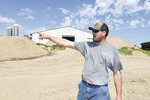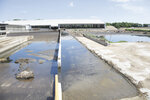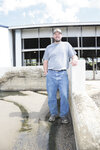


SAUK CENTRE, Minn. — Sand bedding has long been the bedding of choice for Vogt Dairy.
But sand bedding has brought a love-hate relationship to the farm near Sauk Centre.
The Vogt family members said they enjoyed seeing their cows rest comfortably in the stalls but did not like the removal process or hauling sand to their fields.
By adapting to circumstances, the Vogts found a way to keep sand in their barns rather than in their fields via a sand-settling lane.
For the past two years, the Vogts have reclaimed 95% of their sand.
“I knew these worked,” Ethan Vogt said. “It was still hard to wrap my head around using water off the manure pit to wash sand and reuse it.”
Vogt, his brother, Aaron, and his dad, Ken, milk 275 cows. The herd is housed in a 96- by 296-foot freestall barn. After using sand for more than 10 years, they knew something needed to be done to improve their system.
The Vogts have two manure pits located on the south side of their barn. There was a grass patch between the two pits, making an ideal spot to install a sand-settling lane.
“We looked at a few sand lanes,” Vogt said. “We were sick of hauling sand in, pushing it into the pit and hauling it out.”
Vogt said they purchased about 525 loads of sand every year. Each load contained 12 yards of sand. They used the sand one time and pushed it into the pit to be hauled out later.
The west pit was cleaned three times each year, once in the spring and fall and again in December. Vogt said they hauled about 650 loads a year with two tractors. They would haul manure 18 hours a day for five days.
“That’s a lot of fuel, time, wear and tear, plus the hauling with our truck,” Vogt said.
The Vogts’ sand-settling lane is 10 feet by 240 feet with a gradual slope of 0.5%. Every morning the sand is moved from the lane to the beach, which is next to the lane. The beach is slanted toward the lane and allows the sand to drain more water. The sand stays on the beach for 1-2 days to dry before it is moved to a pile. The drained water from the beach will flow back into the lane. In the middle of the lane, there is a valve that water can drain back into the east pit.
“It is just one big loop,” Vogt said.
Water is pumped from the top 2-3 inches of the manure pit. Vogt said they operate the pump at 60% usage during the summer and about 45% usage during the winter since it is on a thermostat. The pump sits on a platform that floats in the east pit.
“This morning (June 12), I took the paddle boat out and greased the pump,” Vogt said. “That’s my entertainment for the summer.”
A 6-inch hose flows the water from the pit to the trough in the barn. As the Vogts clean the pens with a rubber tire scraper, they turn the water on and push it into the trough. This allows the sand to separate, tumble and get washed better. From there, it makes a 90-degree turn to the lane to drain and start the drying process.
“You still have to keep moving it to get the manure water out of it,” Vogt said.
The sand is moved at least four times before it is used again as bedding.
“The closer we get to the pit being full, the more solids have snuck over,” Vogt said.
This causes the sand to get washed with dirtier water. Vogt said this sand is moved 7-8 times before it is used.
“Every time we move it, we will leave the bottom few inches because that is just saturated,” Vogt said.
It takes Vogt about an hour every day to move sand. When Vogt moves piles, he uses a payloader and forage wagon to make the process faster.
“I always joke with people that I am playing in my sandbox,” Vogt said.
The Vogts bring sand into the barn every Tuesday to add to the stalls. Their stalls are 10 inches deep from the top of the curb to the clay.
“We don’t actually have a brisket board,” Vogt said. “We just use sand up front to keep them back.”
In the front of the stall, sand can be up to 18 inches deep after it is added.
“The sand I (have) piled that’s going to go back in the barn next, I would bring home and put it in my kids’ sandbox and not think twice about it; it’s that clean,” Vogt said.
Comments
No comments on this item Please log in to comment by clicking here